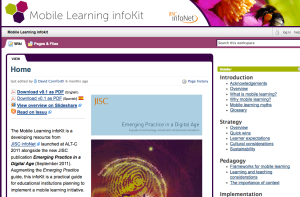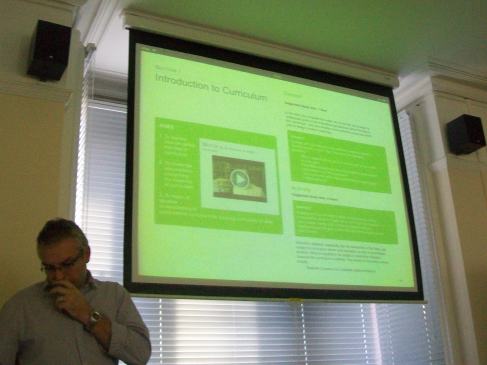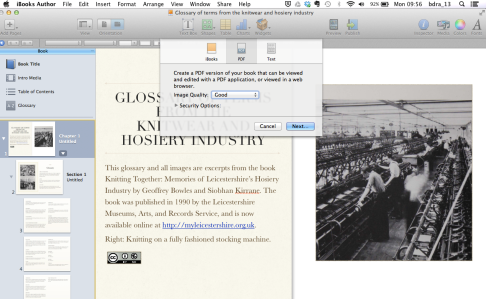Notes on the JISC Mobile Learning InfoKit
as considered in the light of new mobile learning developments and the University of Leicester Places mobile learning evaluation project
The JISC Mobile Learning InfoKit was launched at ALT-C 2011. It was created as a guide for institutions considering the implementation of mobile learning initiatives, especially implementations that are policy-led and sustainable.
This is the first in a series of posts serving as my notebook on this excellent resource, including my thoughts as a result of the 18 months of mobile learning development which have ensued since the launch of the InfoKit, as well as my thoughts as a result of working on the Places project, evaluating mobile learning at the University of Leicester.
I. Overview
“A society which is mobile, which is full of channels for the distribution of a change occurring anywhere, must see to it that its members are educated to personal initiative and adaptability.” (Dewey, 1916)
The key consideration in any mobile learning initiative is the learner. Any institution or individual considering mobile learning should continue to return to questions about benefits to the learner. Gaining feedback from learners is key, as is considering context.
What is mobile learning?
Mobile learning is both a ‘trojan horse’ and a vehicle for exploring the changing nature of learning in a connected age.
Mike Sharples: “the processes (both personal and public) of coming to know through exploration and conversation across multiple contexts amongst people and interactive technologies.” (Sharples, Taylor, & Vavoula, 2005)
Agnes Kukulska-Hulme: “…mobility is the central issue (Winters, 2006). This denotes not just physical mobility but the opportunity to overcome physical constraints by having access to people and digital learning resources, regardless of place and time.” (Kukulska-Hulme, 2010)
MoLeNET: “exploitation of ubiquitous handheld hardware, wireless networking and mobile telephony to facilitate, support, enhance and extend the reach of teaching and learning.” (TribalGroup, 2009)
The one question I have with each one of these defintions is that I wonder if they give enough weight to the older and less sophisticated forms of mobile learning, for example the simple consumption of educational podcasts from an mp3 player. Remember that this was the big new idea which encouraged Duke University to give out iPods to each of its first year students back in 2004 (Joly, 2005) and this was arguably the catalyst for both the proliferation of captured lectures and (not so arguably) the creation of iTunes U. I can say that each of the above definitions does include this form of mobile learning. Yet because mobile learning has so quickly moved to including wireless connectivity with an infinite number of resources and other people, that I think the simple advantage of having learning materials in the palm of one’s hand, for one to spend time on without discussion or interaction, may be regarded as lesser or outdated or even a bad model. I don’t think it is a bad model because it is similar to the simple act of reading a paper book. Indeed, many e-readers sold today are still simple vehicles of e-book delivery and presentation, and do not excel at or even offer interactivity with other materials or people. This is important to consider for our current Places project, because Places studies the use in a University of Leicester programme of tablet PCs which were chosen to essentially serve multimedia learning materials and for which connectivity to other users was an important but secondary consideration when shaping the programme. Also, this project is an outgrowth of a previous project, DUCKLING, in which distance masters students received simple, non-networked ebook readers loaded with instructor-created learning material. It is indeed necessary that mobile learning has moved on to include connectivity to resources and people in the palm of one’s hand, but also I do not want to overlook these other original benefits of mobile learning.
——
Dewey, J. (1916). Democracy and Education: An Introduction to the Philosophy of Education (p. 434). MacMillan.
Joly, K. (2005). Duke University iPod first-year experience: So, was it worth it? | collegewebeditor.com. College Web Editor website. Retrieved August 19, 2011, from http://collegewebeditor.com/blog/index.php/archives/2005/06/16/duke-university-ipod-first-year-experience-so-was-it-worth-it/
Kukulska-Hulme, A. (2010). Mobile learning as a catalyst for change. Open Learning The Journal of Open and Distance Learning, 25(3), 181–185. Retrieved from http://oro.open.ac.uk/23773/1/Open_Learning_editorial_(Accepted_Manuscript).doc
Sharples, M., Taylor, J., & Vavoula, G. (2005). Towards a Theory of Mobile Learning. Mind, 1(1), 1–9.
TribalGroup. (2009). Mobile Learning Network (MoLeNET). Molenet Project Website. Retrieved October 8, 2012, from http://www.m-learning.org/case-studies/molenet-
Terese Bird, Learning Technologist, University of Leicester


